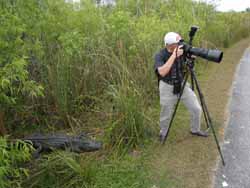 Safety Third!
Safety Third!The photo on the left is of Tom in the Everglades oblivious to the alligator behind him. Actually, there are alligators everywhere and nobody seems worried about them. Maybe if you had a child or a small dog ...
Visit my Home Page.
Want to send me mail? Click here: tomrdavis@earthlink.net.
We had been to Florida a few times before, but it was always on the way to somewhere else in Central or South America. Birding is great in Florida, so we decided to see as much of it as we could in a week. Ellyn did most of the research and we wanted to visit some of our old favorite sites as well as some new ones.
 Safety Third!
Safety Third!
The photo on the left is of Tom in the Everglades oblivious to the alligator behind him. Actually, there are alligators everywhere and nobody seems worried about them. Maybe if you had a child or a small dog ...
We planned a loop from Miami through the Everglades at Shark Valley, and then to Fort Myers for Corkscrew Swamp and the Estero Lagoon at Fort Myers Beach plus maybe Ding-Darling and/or Sanibel Island. From there, we'd go north to Venice Rookery and then across the state to the west to get to Merritt Island. Then we'd head south to Miami. We figured that we'd make more plans as the trip date came closer, and we left some flexibility to visit other sites.
 Route Map
Route Map
Here's a map of the route that we eventually followed on the right. Click on it for a more detailed version.
We talked about our plans with our friends Paul and Anne Ehrlich at the Stanford Center for Conservation Biology and they told us that we must visit the Archbold Biological Station in the center of the state. Paul greased the wheels and set us up with the director of the station. More on that later.
I carried about 50 pounds of photographic equipment and each time I lifted it I was sure I was going to ruin my back, but the flight to Florida went smoothly, and the only problem was trying to find our hotel in Miami late at night. The streets around the Miami airport are about the most confusing I've ever seen.
Although we've been in Florida a few times, we are certainly not experts at the local birds so we often needed to consult the bird book for identification. We'd almost always be able to say, "That looks like an X," but we almost always needed to check to make sure.
Shark Valley consists of a paved trail that goes due south from the road into the Everglades in almost a straight line. There is a sort of river to the west and all manner of water birds can be seen in it.
Here are some photos from Shark Valley:
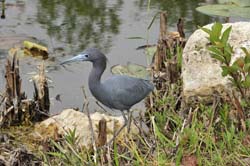 Little Blue Heron (Egretta caerulea)
Little Blue Heron (Egretta caerulea)
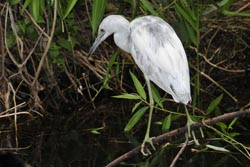 Immature Little Blue Heron (Egretta caerulea)
Immature Little Blue Heron (Egretta caerulea)
This is an immature Little Blue Heron. They start out pure white, but you can see in this image that the bird is starting to get some bluish patches. Compare it with the adult in the image above.
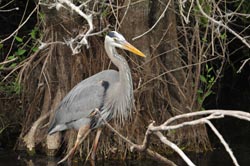 Great Blue Heron (Ardea herodias)
Great Blue Heron (Ardea herodias)
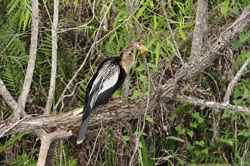 Anhinga (Anhinga anhinga)
Anhinga (Anhinga anhinga)
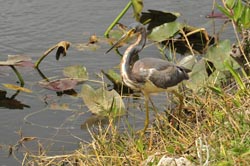 Tricolored Heron (Egretta tricolor)
Tricolored Heron (Egretta tricolor)
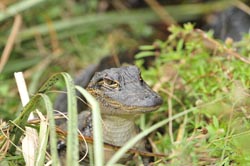 American Alligator (Alligator mississippiensis)
American Alligator (Alligator mississippiensis)
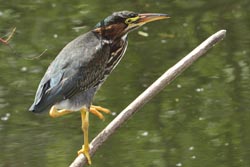
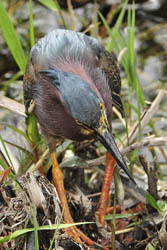 Green Heron (Butorides virescens)
Green Heron (Butorides virescens)
Notice that the guy on the right has a fish (and a somewhat bizarre expression).
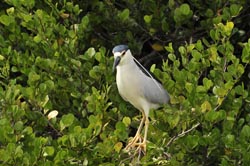 Black-crowned Night-Heron (Nycticorax nycticorax)
Black-crowned Night-Heron (Nycticorax nycticorax)
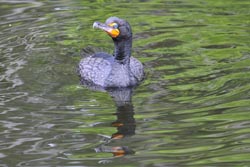 Double Crested Cormorant (Phalacrocorax auritus)
Double Crested Cormorant (Phalacrocorax auritus)
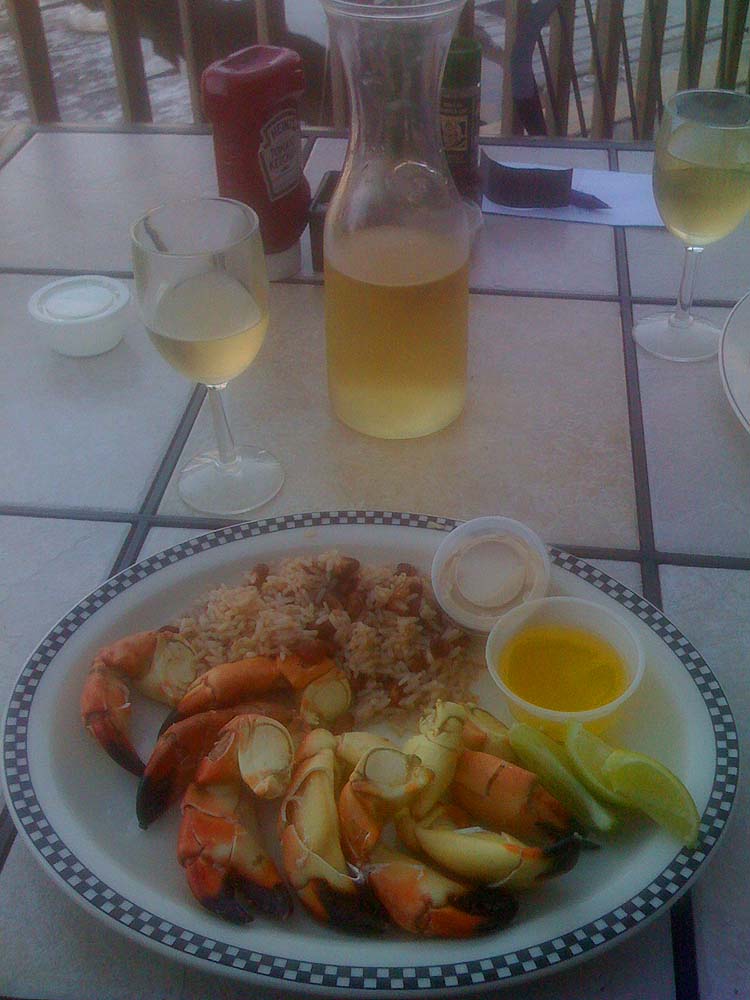 We spent a few hours at Shark Valley and then drove across to near the Gulf coast of Florida and stayed at Ivey House in Everglades City. It was a nice place to stay, but we got there late and didn't have time to do much birding there, other than from the table at the restaurant where we both dined on Stone Crab claws. Here's a photo on the right (taken with my iPhone) of the dinner there.
We spent a few hours at Shark Valley and then drove across to near the Gulf coast of Florida and stayed at Ivey House in Everglades City. It was a nice place to stay, but we got there late and didn't have time to do much birding there, other than from the table at the restaurant where we both dined on Stone Crab claws. Here's a photo on the right (taken with my iPhone) of the dinner there.
We got our first life bird there: the Painted Bunting, but unfortunately, most of the time we looked at it behind a sort of cage at a bird feeder. The cage was to keep the squirrels out. It's a beautiful bird, almost hallucinogenic, there's no doubt you've found it when you see the male. The only photo I got was of the bird inside this "cage".
A bird is called a "life bird" or "lifer" if it's the first time you've ever seen it in your life. Beginning birders get them every day; for us it's a little harder and each one is more exciting than the previous, since each time you see a bird, that reduces the number of possible lifers in the universe by one, so they're rarer and rarer.
A "trash bird" is the opposite of a "lifer": a bird that's so common you see it all the time. Of course if you visit a new area with a really common bird that you've never seen before, the first sighting is a fantastic lifer, and then an hour later you find yourself calling it a trash bird.
There are all sorts of birders, some of whom care a lot about the birds, study them, and are happy to look at the same ones again and again and again. Then there are "listers": birders who simply want to see as many different kinds as possible, and as soon as they've checked them off of their list, they don't care any more. For them, a lifer becomes a trash bird on the second viewing. Well, maybe not that extreme, but I've sure met some listers in my day.
We met a lot of nice people as we hiked along. In fact, we met a lot of nice people almost everywhere we stopped during the trip. Any time you saw somebody in a spot where mostly birders go, and that somebody has at least $500 in optics hanging around their neck, you know you can talk to them. We got a bunch of good suggestions for other places to visit (including the Sarasota Landfill, of all places). Actually, landfills and sewage-treatment plants are often a great spot to see birds, although the scenery isn't all that great.
Later in the day, we were walking along the boardwalk and met a guy with a very strong British accent. He asked if we'd seen the "snipe". We hadn't, and he pointed into the swamp where we saw nothing. "Where?", we asked, and he kept pointing, and said, "Two meters away." Finally, we figured out that it wasn't a "snipe", but a "snake", but with a heavy accent, pronounced something like "snike". Once you know you're looking for a snake instead of a bird, it's easy to find, but this one was a bit camouflaged (black snake in a very dark swamp gunk) but it was hefty.
At just about noon, disaster struck. I was carrying a big lens (200-400mm f/4) with a big camera body (Nikon D3) and a hefty flash all mounted on a big tripod and very solid tripod head. The head screws into a part that's connected to the tripod legs, and that piece broke off from the legs, causing all the fancy camera gear to crash down on the boardwalk. That was the end of the camera body. I haven't sent it in for repairs yet, but if I'm unlucky, the sensor is damaged or if I'm lucky, it's just the mirror retraction mechanism that's broken.
Luckily, I had had the sense to take along my older camera body as a backup, and although the older one isn't as nice, it was certainly way better than nothing. All the photos for the rest of the trip were taken with that Nikon D2x body.
The fall also slightly damaged the flash, but not in a way that caused it not to work. It just wouldn't work for wide-angle photos, of which I took exactly zero during the entire trip.
Here are some photos of the critters in Corkscrew Swamp:
 Swallow-tailed Kite (Elanoides forficatus)
Swallow-tailed Kite (Elanoides forficatus)
 Painted Bunting (Passerina ciris)
Painted Bunting (Passerina ciris)
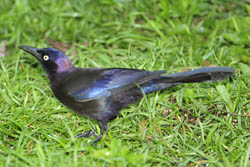 Common Grackle (Quiscalus quiscula)
Common Grackle (Quiscalus quiscula)
 Squirrel
Squirrel
He's the reason that the Painted Bunting is in a cage.
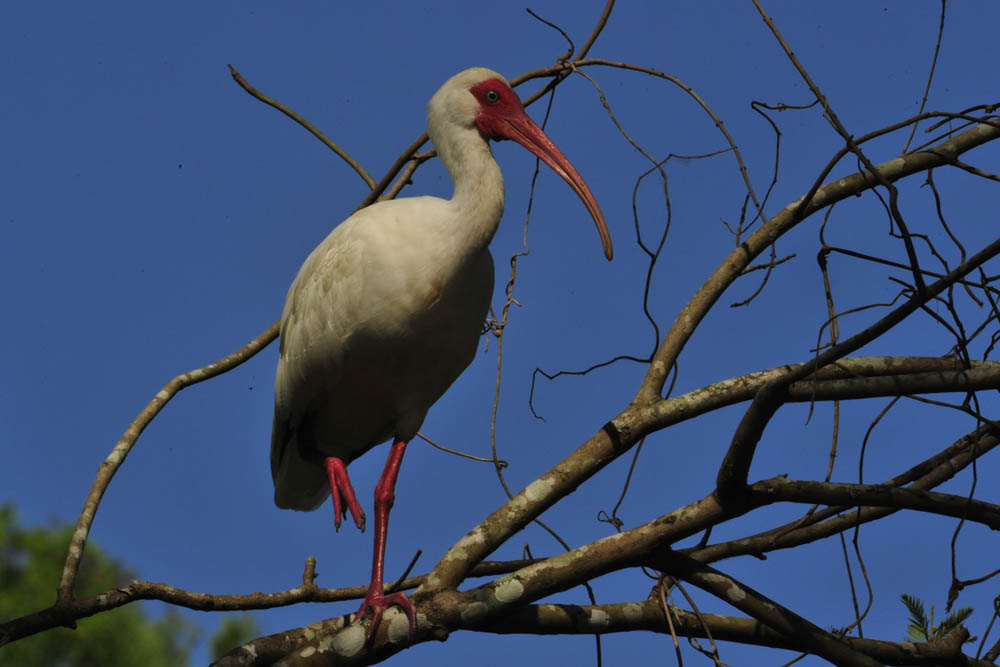 White Ibis (Eudocimus albus)
White Ibis (Eudocimus albus)
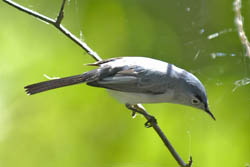 Blue-gray Gnatcatcher (Polioptila caerulea)
Blue-gray Gnatcatcher (Polioptila caerulea)
 Red-shouldered Hawk (Buteo lineatus)
Red-shouldered Hawk (Buteo lineatus)
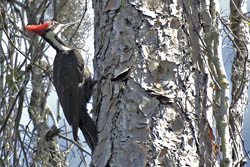 Pileated Woodpecker (Dryocopus pileatus)
Pileated Woodpecker (Dryocopus pileatus)
Fort Myers Beach is the last place you'd expect to find good birding: there's one main road, packed on both sides with condos and hotels. But behind the Holiday Inn, as advertised, was a wonderful lagoon full of wildlife.
We got up before the crack of dawn and waited and waited and waited. There were a bunch of Little Blue Herons that kept making us think we'd found our bird, but nothing. We walked up and down the estero a couple of times, spotted some other birds (like the male Northern Cardinal, which I'm sure is a "trash bird" for folks in the east, but which is spectacular for us Californians).
Finally, Ellyn spotted the Reddish Egret flying by, but it disappeared behind some mangroves. We raced around to the other side (well, "raced" may not be the correct word when you're lugging all that camera equipment) and searched and searched, but never found him. We were beginning to get discouraged, since it was getting to be around 11:00 o'clock.
We were giving the bird one last chance when it finally did show up, and landed in the lagoon close enough for some photos.
It was nothing like what I expected. I've seen a million egrets and herons before, and almost all behave like cats looking for prey: they slowly creep up on their target, or wait patiently for it to come closer, after which there's a sharp jab that's either successful or not.
But the Reddish Egret is a maniac: it runs back and forth (to the great dismay of this photographer trying to get a shot that's not a perfect bad example of motion blur), occasionally tossing its wings up over its head to shadow the water from the sun, then jabbing wildly, usually missing, and then continuing the crazed dance. We watched for about an hour. I really like the shading maneuver; I've never seen anything like it with other birds.
The Reddish Egret was our second life bird of the trip.
As usual, we met a lot of nice people on the beach: a couple of birders, of course, but mostly just retired folks out for a walk. They all seemed to be interested in what we were doing and were (or appeared to be) really happy when we pointed out to them "a really 'good' bird". Of course from the birders we learned that we had just missed the Roseate Spoonbill: "they were all over the place here yesterday", and apparently there's a Scarlet Ibis on the island as well -- lost and a long way from home, but hanging out with the local ibises.
Here are a bunch of images from the Estero Lagoon:
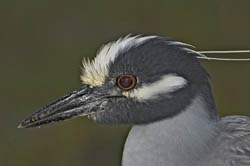 Yellow-crowned Night-Heron (Nyctanassa violacea)
Yellow-crowned Night-Heron (Nyctanassa violacea)
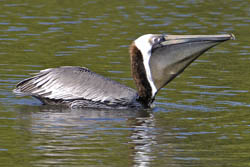 Brown Pelican (Pelecanus occidentalis)
Brown Pelican (Pelecanus occidentalis)
 Laughing Gull (Larus atricilla)
Laughing Gull (Larus atricilla)
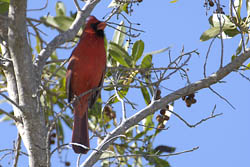 Northern Cardinal (Cardinalis cardinalis)
Northern Cardinal (Cardinalis cardinalis)
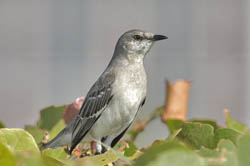 Northern Mockingbird (Mimus polyglottos)
Northern Mockingbird (Mimus polyglottos)
 Little Blue Heron (Egretta caerulea)
Little Blue Heron (Egretta caerulea)


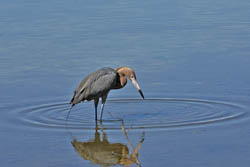 Reddish Egret (Egretta rufescens)
Reddish Egret (Egretta rufescens)
At least this was supposedly "the" place to see them. If you're looking for a relatively rare bird, you can usually look it up on the internet and find pretty good directions to likely sites, and that's what we did. In fact, as you drive along the appropriate road (Oilwell Grade: being from California, all of Florida seems dead flat, so calling this road a "grade" seemed really strange to me), at this site there's sign with "RCW" on it, and all the trees with nests have a white stripe painted around them at chest height. But even with all of that, we spent a long time looking. We'd drive the car to the next clump of marked trees, hike around looking for anything, and then back to the car and on.
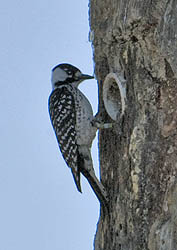 Red-cockaded Woodpecker (Picoides borealis)
Red-cockaded Woodpecker (Picoides borealis)
When we got to the end of the line with no luck, we turned around and repeated the procedure, and finally, we heard the sound of some woodpecker hammering on a tree. I got a glimpse of one flying away, but not enough for a positive ID. We saw another couple (with the correct optics around their necks) and they had found another one. He was far away, but we got a good look. I took a photo, but it's the worst bird shot of the trip which you can see in the thumbnail on the left. If you want to see a good photo of one taken by somebody else, click on the thumbnail and be taken to a really good photo I found on the internet, taken by somebody else.
In the image you obtain by clicking the thumbnail that the bird is color-banded. The usual bands are aluminum (and this one probably has a standard aluminum band on its left leg) but on the right are a pair of colored bands (and there may be other colored bands on the left) so that researchers can identify individual birds in the field with their binoculars.
We didn't see much of anything else of interest there except for a Loggerhead Shrike which was the first one I'd seen in a few years. But we were really pleased to see the RCW; it was our third life bird of the trip.
The rookery is right in the middle of a city, but it's in a park on a small island in the middle of a lake, and when we were there, we found a lot of birds on the island taking care of their young.
I hung around the island taking some photos and Ellyn wandered around to see what she could find. She came running back to report a new lifer: the Sandhill Crane. The first one she found was an immature, and she thought, "what a dirty Great Blue Heron", but a second look made it clear that it wasn't a heron at all. Then she found an adult and the ID was obvious. I took the camera over, and got a lot of photos, but the backgrounds weren't great.
Here are some photos from the Venice Rookery:
 Sandhill Crane (Grus canadensis)
Sandhill Crane (Grus canadensis)
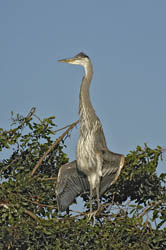 Great Blue Heron (Ardea herodias)
Great Blue Heron (Ardea herodias)
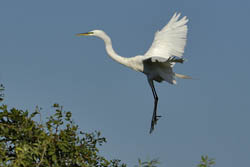 Great Egret (Ardea alba)
Great Egret (Ardea alba)
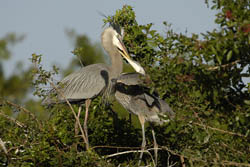 Great Blue Heron (Ardea herodias) feeding a chick
Great Blue Heron (Ardea herodias) feeding a chick
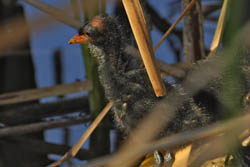 Common Moorhen (Gallinula chloropus) chick
Common Moorhen (Gallinula chloropus) chick
These little guys look like dinosaurs. I didn't get a good photo of the parent here, but I did later, in the Viera Wetlands. See below.
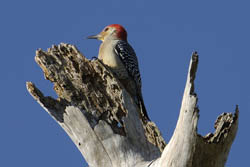 Red-bellied Woodpecker (Melanerpes carolinus)
Red-bellied Woodpecker (Melanerpes carolinus)
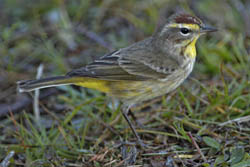 Palm Warbler (Dendroica striata)
Palm Warbler (Dendroica striata)
We signed in at the entrance and apparently the place is so popular with birders that they provide a bird list: a list of the birds seen in the landfill.
We saw a lot of stuff, but the best birds were Bald Eagles (flying mixed with the Turkey Vultures and Black Vultures) and we got another good look at a Sandhill Crane. I got some good flight shots of the Bald Eagles:
 Bald Eagle (Haliaeetus leucocephalus) perched
Bald Eagle (Haliaeetus leucocephalus) perched
 Bald Eagle (Haliaeetus leucocephalus) in flight
Bald Eagle (Haliaeetus leucocephalus) in flight
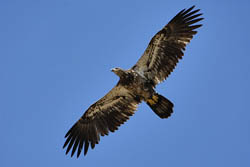 Immature Bald Eagle (Haliaeetus leucocephalus)
Immature Bald Eagle (Haliaeetus leucocephalus)
When we left, we took a long drive to Sebring, Florida (where the big auto race-track is found), because it was just a few miles from Archbold Biological Station. We drove through Myakka River State Park on the way and stopped to look around, but didn't see too much. Again, we were not there at the best time of day for birding. There were a lot of feral pigs, though.
We got to Archbold on time and met Shane who drove us directly to the site where we got the easiest life bird of the trip: the Florida Scrub-Jay. Shane studies them and knows exactly where they can be found. In fact, that very morning he'd been busy looking for them, since once per month the Scrub-Jay researchers go out and try to find all of them. Every bird there is color-banded and they try to keep track of all of them.
The birds are very territorial, and family groups defend their territories. Shane just drove to a likely spot, "pished" a couple of times, and we were surrounded by a half dozen of the jays. ("Pishing" is making a noise that sounds like "pish" or "psssh" that seems to draw out birds sometimes.) He then tossed out a few peanuts and that guaranteed that the birds would hang around for a while.
The idea of feeding the birds peanuts is somewhat controversial, since it upsets the "natural" order of things (like most jays, these birds eat almost anything, but primarily they eat acorns) but Shane said that although he was very skeptical about the practice at first, he, and most others, have decided that it has almost no effect. The birds just get a few peanuts, and it's an incredibly useful way to observe them. When they arrive for the peanuts, they eat a few and when the peanuts stop coming, they just start doing what they were doing before, but now right under the eyes of the researcher.
Since the station's grounds are pretty much closed to anyone but researchers and their guests, the birds that are used to the peanuts are not likely to get into trouble by being accustomed to people. They almost never leave their territories, so it's not like they'll get in trouble outside the site, either.
Shane took us to another site as well, where there was one particular bird that's so tame that it'll land in your hand to take peanuts. He also showed us a nest that had been abandoned, but was still in pretty good shape. The researchers try to find all the nests as well, which is basically impossible, but Shane thinks they probably get between 90% and 95% of them which is amazing.
At least the nests are relatively near the ground, so it's not as hard as looking for them in the rainforest canopy, and it's pretty easy to get around on the site since it's flat and you can walk almost anywhere. There are not a lot of trees, so you can see the birds at a long distance, and if you see a bird carrying nesting materials, you'll have a good clue about where the nest is.
Shane was a great guide, we sure learned a lot. He got us back to the headquarters in time to meet with the station director, Hilary Swain, who gave us a great tour of the station itself and a history lesson. She also took us up to the top of the water tower from which point we could see miles in every direction and get a good feeling for what was going on.
The Florida Scrub-Jay is endemic to Florida ("endemic" means that you find it only there, and nowhere else in the world) and it's endangered because housing and citrus orchards continually encroach on the scrubland it requires. Another problem is that they like to live in young oak forests. (The "oaks" are very scrubby, and most are less than four feet high.) "Young" means about five years.
In the "natural" state, the area burns regularly, but when there are houses, the inhabitants usually don't like to have the surroundings burn, so growth continues and is soon unsuitable for the jays. At the station, meticulous records are kept of what has burned and when, and artificial fires are set regularly to keep the area "natural". In fact, if you're a researcher there, you can look up which sites are one, two, three, eight, twenty, or whatever years post-burn to see exactly what such an area contains in terms of plants and animals.
Anyway, we had a great time and are very thankful to both Hilary and Shane for their time. As we were about to leave, Hilary asked if we'd seen the Crested Caracara, which we had not. She told us exactly where to look in another part of the Station (a recently-purchased ranch) and we went there after we left. We finally saw the Caracara, but no photos, and we saw dozens of American Kestrels in the site.
One interesting thing that Hilary explained is how she managed to make a killing in Florida real-estate for the station. They acquired a few thousand acres of land at about $1400 per acre just before land prices went nuts. Then, a few years later prices had gone up so much that simply by selling an easement to some of the land for conservation purposes, she got $1800 per acre just for an easement, and the station still owns the land. A couple of years later, the easement prices had skyrocketed, and she sold some more, making the whole land acquisition basically free.
Here are a few photos taken at the station:
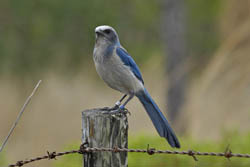 Florida Scrub Jay (Aphelocoma coerulescens)
Florida Scrub Jay (Aphelocoma coerulescens)
Notice that this guy is color banded.
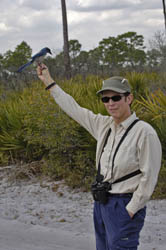 Florida Scrub Jay (Aphelocoma coerulescens) eating peanuts out of Ellyn's hand
Florida Scrub Jay (Aphelocoma coerulescens) eating peanuts out of Ellyn's hand
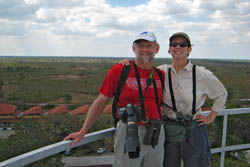 Tom and Ellyn
Tom and Ellyn
This is the view from the top of the water tower at Archbold Station.
It seems to be impossible to contact anyone at the refuge for information about closure times, although we tried a number of times. What we decided to do was just to drive toward the refuge until we got there or were turned around. It was only about six miles from our hotel, and if it were closed, there are a number of other places nearby where we might get some good birding.
As we drove in, there was a sign saying "Canaveral Seashore closed", but that's different from Merritt Island, and there were no gates, so we just went in.
There's a very nice drive called "Black Point Wildlife Drive" that's about seven miles long and we drove it at about five mph, stopping frequently. We didn't see much new, but there were a lot of birds, and Ellyn did spot a rail-like bird (probably a Sora, but we didn't get a positive ID). Again, we missed the Roseate Spoonbills ("they were just here yesterday"), and we talked to a lot of folks who told us that normally the birding is better, but with the drought, there just wasn't enough water. We did get a good piece of information, however, and that was to visit the "Viera Wetlands" on our way south to Miami.
After finishing the loop, we drove to the "Scrub Ridge Trail" where there's a good chance of seeing the Florida Scrub-Jay. A gal who was just finishing her hike claimed to have seen some within the last half-hour, but it was hot, and made a half-hearted search since we'd gotten such a good look the day before.
Finally, we drove out to the Manatee Observation Deck and saw our first manatees, so they were "lifers", I guess, but not birds. It wasn't a very good view -- they were behind some bushes and looked a lot like submerged rocks that occasionally moved. I did see the head of one for just a second. I think that the birders we were talking to must not have thought much of us for giving up on the Scrub-Jay so quickly, since we didn't tell them we'd gotten the best look in the world the day before.
Here are a couple of photos from the reserve; not much to look at.
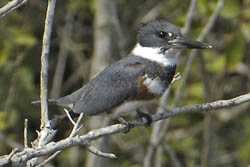 Belted Kingfisher (Ceryle alcyon)
Belted Kingfisher (Ceryle alcyon)
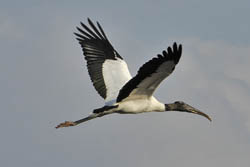 Wood Stork (Mycteria americana)
Wood Stork (Mycteria americana)
Then we screwed up.
For a Californian, Florida is initially confusing simply because the Ocean is to the east, not to the west. That's complicated even more by the fact that we went from the Atlantic side to the Gulf side and then back to the Atlantic side, and I was always mixing up east and west and whether the water was east or west. Also, since Florida is so flat, there are no hills for orientation, and I was always afraid of messing up.
But this time I knew where the ocean was from the restaurant, and I headed there. And we drove and drove, and there was no Viera Wetlands. Finally, we figured it out: the wetlands were not near the ocean; they were inland. In fact, they're next to a wastewater treatment plant, and they are totally artificial: a levee was built around many, many acres and filled with water.
At first we just saw "trash birds" and thought we'd wasted our time, but then Ellyn spotted an American Bittern! These are not easy to find, and in fact even though we knew where it was, we kept losing it as it crept around. I was able to get a fairly decent photo finally.
We also got our best view of a Sandhill Crane and a fairly nice photo of a Tricolored Heron. Here they are:
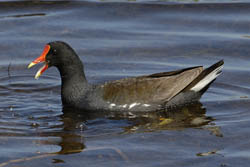 Common Moorhen (Gallinula chloropus)
Common Moorhen (Gallinula chloropus)
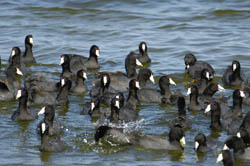 American Coots (Fulica americana)
American Coots (Fulica americana)
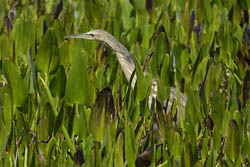 American Bittern (Botaurus lentiginosus)
American Bittern (Botaurus lentiginosus)
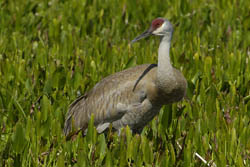 Sandhill Crane (Grus canadensis)
Sandhill Crane (Grus canadensis)
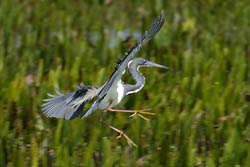
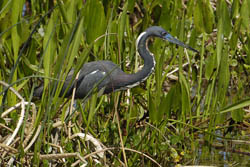 Tricolored Heron (Egretta tricolor)
Tricolored Heron (Egretta tricolor)
We spent a couple of hours there and then headed south to Boynton Beach where we'd spend the last night and wake up an hour away from the Miami airport for a flight home.
We were very lucky at the refuge in that we ran into a group of birders heading out when we arrived. They were perfectly happy to include a couple of strangers and they had some pretty good birders in the group who could help with spotting stuff and with identification. They also had a couple of spotting scopes for far-away birds. (Binoculars usually are between 7 and 10 power, since they're hand-held; spotting scopes are mounted on tripods and can sometimes go up to 60 power.)
We were looking for the Snail Kite, specifically. We'd never seen it in the United States (but had in Costa Rica), so it would be a "lifer" for the states, if we could find one.
Almost immediately, one flew over. I'm not sure I would have identified it with the look we had, but the people we were with had been out there so many times that they were certain. They also spotted a flying American Bittern (our second of the trip, and the first one I've ever seen in the air).
I got a couple of decent photos of a Red-shouldered Hawk and a crappy photo of the Snail Kite on a branch since he was just too far away.
The group finally headed back to the parking lot and Ellyn and I still had a half hour so we headed out on a levee where we might get a better look at the Kite. There in front of us (but pretty far away) were a pair of Bobcats! I got a photo that's not great, but good enough for an ID. Then we found the Snail Kite perched relatively close on a branch and I got a fair photo. Finally, as we headed back to the parking lot, a couple of otters ran past and I got one half-decent shot of them.
Here are some photos from Loxahatchee:
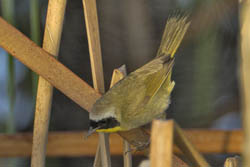 Common Yellowthroat (Geothlypis trichas)
Common Yellowthroat (Geothlypis trichas)
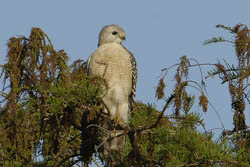 Red-shouldered Hawk (Buteo lineatus)
Red-shouldered Hawk (Buteo lineatus)
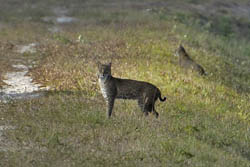 Bobcat (Lynx rufus (was Felis rufus))
Bobcat (Lynx rufus (was Felis rufus))
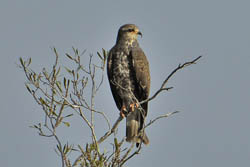 Snail Kite (Rostrhamus sociabilis)
Snail Kite (Rostrhamus sociabilis)
Look at the hooked beak which it uses to pull snails out of their shells. This particular bird is also banded. In the large image, you can see bands with the letters "K2" on the right leg.
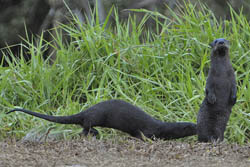 River Otters (Lutra canadensis)
River Otters (Lutra canadensis)
The trip home was uneventful, and our dog was really happy to see us. The only bird we'd specifically wanted to see but didn't was the Roseate Spoonbill.